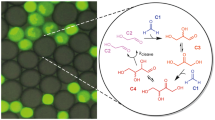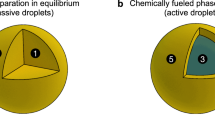Abstract
It has been proposed that during the early steps in the origin of life, small droplets could have formed via the segregation of molecules from complex mixtures by phase separation. These droplets could have provided chemical reaction centres. However, whether these droplets could divide and propagate is unclear. Here we examine the behaviour of droplets in systems that are maintained away from thermodynamic equilibrium by an external supply of energy. In these systems, droplets grow by the addition of droplet material generated by chemical reactions. Surprisingly, we find that chemically driven droplet growth can lead to shape instabilities that trigger the division of droplets into two smaller daughters. Therefore, chemically active droplets can exhibit cycles of growth and division that resemble the proliferation of living cells. Dividing active droplets could serve as a model for prebiotic protocells, where chemical reactions in the droplet play the role of a prebiotic metabolism.
This is a preview of subscription content, access via your institution
Access options
Subscribe to this journal
Receive 12 print issues and online access
$209.00 per year
only $17.42 per issue
Buy this article
- Purchase on Springer Link
- Instant access to full article PDF
Prices may be subject to local taxes which are calculated during checkout





Similar content being viewed by others
References
Oparin, A. I. Origin of Life (Dover, 1952).
Haldane, J. B. S. The origin of life. Ration. Annu. 148, 3–10 (1929).
Brangwynne, C. P. et al. Germline P granules are liquid droplets that localize by controlled dissolution/condensation. Science 324, 1729–1732 (2009).
Koga, S., Williams, D. S., Perriman, A. W. & Mann, S. Peptide-nucleotide microdroplets as a step towards a membrane-free protocell model. Nat. Chem. 3, 720–724 (2011).
Crosby, J. et al. Stabilization and enhanced reactivity of actinorhodin polyketide synthase minimal complex in polymer–nucleotide coacervate droplets. Chem. Commun. 48, 11832 (2012).
Sokolova, E. et al. Enhanced transcription rates in membrane-free protocells formed by coacervation of cell lysate. Proc. Natl Acad. Sci. USA 110, 11692–11697 (2013).
Hyman, A. A., Weber, C. A. & Jülicher, F. Liquid-liquid phase separation in biology. Annu. Rev. Cell Dev. Biol. 30, 39–58 (2014).
Tang, T.-Y. D., van Swaay, D., DeMello, A., Ross Anderson, J. L. & Mann, S. In vitro gene expression within membrane-free coacervate protocells. Chem. Commun. 51, 11429–11432 (2015).
Bray, A. Theory of phase-ordering kinetics. Adv. Phys. 43, 357–459 (1994).
Ostwald, W. Studien über die Bildung und Umwandlung fester Körper. Z. Phys. Chem. 22, 289–330 (1897).
Lifshitz, I. M. & Slyozov, V. V. The kinetics of precipitation from supersaturated solid solutions. J. Phys. Chem. Solids 19, 35–50 (1961).
Binder, K. & Stauffer, D. Statistical theory of nucleation, condensation and coagulation. Adv. Phys. 25, 343–396 (1976).
Voorhees, P. W. Ostwald ripening of two-phase mixtures. Annu. Rev. Mater. Sci. 22, 197–215 (1992).
Zwicker, D., Decker, M., Jaensch, S., Hyman, A. A. & Jülicher, F. Centrosomes are autocatalytic droplets of pericentriolar material organized by centrioles. Proc. Natl Acad. Sci. USA 111, E2636–E2645 (2014).
Zwicker, D., Hyman, A. A. & Jülicher, F. Suppression of Ostwald ripening in active emulsions. Phys. Rev. E 92, 012317 (2015).
Puri, S. & Frisch, H. Segregation dynamics of binary mixtures with simple chemical reactions. J. Phys. A 27, 6027–6038 (1994).
Glotzer, S. C., Stauffer, D. & Jan, N. Monte Carlo simulations of phase separation in chemically reactive binary mixtures. Phys. Rev. Lett. 72, 4109–4112 (1994).
Carati, D. & Lefever, R. Chemical freezing of phase separation in immiscible binary mixtures. Phys. Rev. E 56, 3127–3136 (1997).
Huggins, M. L. Solutions of long chain compounds. J. Chem. Phys. 9, 440 (1941).
Flory, P. I. Thermodynamics of high polymer solutions. J. Chem. Phys. 10, 51–61 (1942).
Oparin, A. Proiskhozhedenie Zhizni Mosckovskii Rabochii (Reprinted and translated in JD Bernal (1967) The Origin of Life London; Weidenfeld and Nicolson, 1924).
Turing, A. The chemical basis of morphogenesis. Phil. Trans. R. Soc. Lond. 237, 37–72 (1952).
Gierer, A. & Meinhardt, H. A theory of biological pattern formation. Biol. Cybern. 12, 30–39 (1972).
Mullins, W. W. & Sekerka, R. F. Morphological stability of a particle growing by diffusion or heat flow. J. Appl. Phys. 34, 323–329 (1963).
Langer, J. S. Instabilities and pattern formation in crystal growth. Rev. Mod. Phys. 52, 1–28 (1980).
Woese, C. R., Kandler, O. & Wheelis, M. L. Towards a natural system of organisms: proposal for the domains Archaea, Bacteria, and Eucarya. Proc. Natl Acad. Sci. USA 87, 4576–4579 (1990).
Fox, S. W. The evolutionary significance of phase-separated microsystems. Orig. Life 7, 49–68 (1976).
Brangwynne, C. P. Soft active aggregates: mechanics, dynamics and self-assembly of liquid-like intracellular protein bodies. Soft Matter 7, 3052–3059 (2011).
Toretsky, J. A. & Wright, P. E. Assemblages: functional units formed by cellular phase separation. J. Cell Biol. 206, 579–588 (2014).
Weber, S. C. & Brangwynne, C. P. Getting RNA and protein in phase. Cell 149, 1188–1191 (2012).
Elbaum-Garfinkle, S. et al. The disordered P granule protein LAF-1 drives phase separation into droplets with tunable viscosity and dynamics. Proc. Natl Acad. Sci. USA 112, 7189–7194 (2015).
Molliex, A. et al. Phase separation by low complexity domains promotes stress granule assembly and drives pathological fibrillization article phase separation by low complexity domains promotes stress granule assembly and drives pathological fibrillization. Cell 163, 123–133 (2015).
Lin, Y. et al. Formation and maturation of phase-separated liquid droplets by RNA-binding proteins article formation and maturation of phase-separated liquid droplets by RNA-binding proteins. Mol. Cell 60, 1–12 (2015).
Gilbert, W. Origin of life: the RNA world. Nature 319, 618 (1986).
Higgs, P. G. & Lehman, N. The RNA World: molecular cooperation at the origins of life. Nat. Rev. Genet. 16, 7–17 (2015).
Fedor, M. J. & Williamson, J. R. The catalytic diversity of RNAs. Nat. Rev. Mol. Cell Biol. 6, 399–412 (2005).
Unrau, P. J. & Bartel, D. P. RNA-catalysed nucleotide synthesis. Nature 395, 260–263 (1998).
Hanczyc, M. M., Fujikawa, S. M. & Szostak, J. W. Experimental models of primitive cellular compartments: encapsulation, growth, and division. Science 302, 618–622 (2003).
Hanczyc, M. M. & Szostak, J. W. Replicating vesicles as models of primitive cell growth and division. Curr. Opin. Chem. Biol. 8, 660–664 (2004).
Macía, J. & Solé, R. V. Synthetic Turing protocells: vesicle self-reproduction through symmetry-breaking instabilities. Phil. Trans. R. Soc. B 362, 1821–1829 (2007).
Murtas, G. Early self-reproduction, the emergence of division mechanisms in protocells. Mol. Biosyst. 9, 195–204 (2013).
Browne, K. P., Walker, D. A., Bishop, K. J. M. & Grzybowski, B. A. Self-division of macroscopic droplets: partitioning of nanosized cargo into nanoscale micelles. Angew. Chem. Int. Ed. Engl. 49, 6756–6759 (2010).
Patashinski, A. Z., Orlik, R., Paclawski, K., Ratner, M. A. & Grzybowski, B. A. The unstable and expanding interface between reacting liquids: theoretical interpretation of negative surface tension. Soft Matter 8, 1601–1608 (2012).
Giomi, L. & DeSimone, A. Spontaneous division and motility in active nematic droplets. Phys. Rev. Lett. 112, 147802 (2014).
Baross, J. & Hoffman, S. Submarine hydrothermal vents and associated gradient environments as sites for the origin and evolution of life. Orig. Life Evol. Biosph. 15, 327–345 (1985).
Martin, W. F. Hydrogen, metals, bifurcating electrons, and proton gradients: the early evolution of biological energy conservation. FEBS Lett. 586, 485–493 (2012).
Martin, W. F., Sousa, F. L. & Lane, N. Evolution. Energy at life’s origin. Science 344, 1092–1093 (2014).
Atkins, P. & de Paula, J. Atkins’ Physical Chemistry (OUP Oxford, 2010).
Kacser, H., Burns, J. A. & Fell, D. A. The control of flux. Biochem. Soc. Trans. 23, 341–366 (1995).
Acknowledgements
We would like to thank D. Tang for a critical reading of our manuscript.
Author information
Authors and Affiliations
Contributions
All authors developed the project and wrote the paper together. Numerical solutions of the continuum model were obtained by R.S. and D.Z.
Corresponding author
Ethics declarations
Competing interests
The authors declare no competing financial interests.
Supplementary information
Supplementary information
Supplementary information (PDF 643 kb)
Supplementary Movie 1
Supplementary Movie (MPG 1240 kb)
Supplementary Movie 2
Supplementary Movie (MPG 2316 kb)
Rights and permissions
About this article
Cite this article
Zwicker, D., Seyboldt, R., Weber, C. et al. Growth and division of active droplets provides a model for protocells. Nature Phys 13, 408–413 (2017). https://doi.org/10.1038/nphys3984
Received:
Accepted:
Published:
Issue Date:
DOI: https://doi.org/10.1038/nphys3984
This article is cited by
-
Multicompartmental coacervate-based protocell by spontaneous droplet evaporation
Nature Communications (2024)
-
Dynamic control of DNA condensation
Nature Communications (2024)
-
Evidence for widespread cytoplasmic structuring into mesoscale condensates
Nature Cell Biology (2024)
-
Artificial cell synthesis using biocatalytic polymerization-induced self-assembly
Nature Chemistry (2024)
-
The reproduction process of Gram-positive protocells
Scientific Reports (2024)



